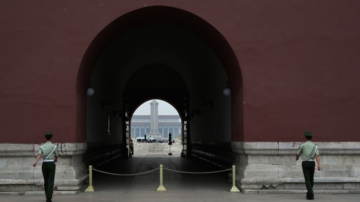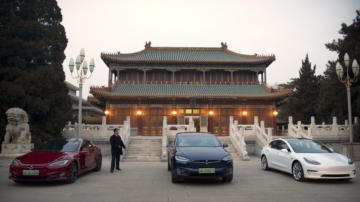【新唐人2013年08月14日訊】丹麥赫爾辛格市議員亞朗(Fuat Yalan)最近脫口說出,「希望高溫燒死中國人」,此舉不但在丹麥引起軒然大波,也引發中國網民的撻伐,亞朗事後也提出道歉。目前,中國遭遇盛夏高溫,至少超過40個城市,氣溫超過攝氏40度,老百姓叫苦連天。到底是甚麼原因導致了這次罕見的高溫天氣呢?有不少網民認為,創新的高溫恐怕與「三峽」大壩攔水和南水北調有關。我們來看專家的分析。
7月以來,中國南方上海、浙江、湖南、貴州等多個省份,高溫熱浪強度為1951年以來最高。與此同時,平均降水量僅為99.2毫米,較常年同期偏少一半以上,為1951年以來歷史同期最少。其中,浙江省奉化市最高氣溫已經突破攝氏43度,連續一週蟬聯中國「高溫之冠」。
持續高溫讓中國素有「水鄉澤國」之稱的長江中下游地帶,呈現一大片乾旱,創新的高溫記錄已經給民眾帶來了災難性的影響。據統計,截至8月8號,湖南、貴州、湖北、江西、浙江、重慶、安徽等大約有4682.5萬人受災,直接經濟損失263.9億元。
高溫烤焦了西湖龍井茶樹、浙江大量乾枯的蔬菜,重慶10萬畝農作物受災,各地頻頻傳出災情。有專家認為,大陸高溫天氣的出現是由於北亞地區的副熱帶高壓系統阻礙了雲團的形成。但專家同時指出,城市化進程加快以及全球氣候變暖也導致高溫現象加劇。
另外,不少網民提出,真正原因恐怕與「三峽」大壩攔水和南水北調有關。
水利專家王維洛:「重慶按照中國(共)政府當時做的三峽工程環境評估報告來看的,重慶應該起碼能夠在最高氣溫降低4度,那麼就是說,重慶最高氣溫是不能超過38度,而今年重慶的氣溫已經達到42度,現在這個事實,就是推翻了中國政府所說的三峽工程對氣候的影響很小的這個結論。」
旅居德國的水利專家王維洛2006年曾撰文指出,1986年三峽大壩的第一次環評報告結論是:三峽工程對環境的影響是弊大於利。不過,對這個結論中央決策層表示不滿意。1991年中共國務院三峽工程審查小組否定了這個報告。原生態與環境組副組長方子雲出任環境二組組長後,負責重新編寫環評報告。最後拍版定案的結論是:三峽工程對環境的影響是利大於弊。
方子雲在1992年發表了三峽工程系列叢書的《生態與環境》,預測極端最高氣溫可下降約4攝氏度,極端最低溫度增高3攝氏度左右。當時中共當局把他的觀點進行大肆宣傳,推銷三峽工程是一個天然空調機。
水利專家王維洛:「三峽工程送上馬以後,在今年重慶就多次突破它的最高氣溫,突破歷史最高氣溫,所以三峽工程也沒有發揮它的所謂的空調機的作用,沒有使最高氣溫下降4度,而是最高氣溫還有所增加。」
事實證明,三峽工程並沒有使重慶冬暖夏涼,反而成為一個大火爐。大壩成為人工屏障,水氣無法正常進出四川盆地循環交替,高溫就隨之而生。
重慶成了現在中國極端惡劣氣候的代表,乾旱時可以連續兩個月高溫無雨,50天氣溫超過40度﹔暴雨時也可以兩天之內降下300mm,佔全年降水量的1/4。
王維洛指出,當年提出三峽大壩工程「利多於弊」主張的所謂專家,終身享受政府的特殊津貼,不用為環評報告的錯誤結論承擔任何責任,但工程的費用卻由全中國的老百姓買單。
採訪/陳漢 編輯/黃億美 後製/郭敬
Rare High Temperature in China Comes from Three Gorges Dam
Fuat Yalang, a Denmark city council member,
recently blurted out,
"I hope the Chinese people get burned to death
by the high temperature."
Yalang's remark caused an uproar in both Denmark
and China, and he had to apologize afterwards.
Currently, China is experiencing a hot summer.
The temperature in more than 40 cities exceeded
104 degrees, causing people to suffer a great deal.
What caused such unusually hot weather?
Many netizens believe it has something to do with
the Three Gorges Dam. Let's look at the experts' analysis.
Since July, a heat wave in Southern China's Shanghai,
Zhejiang, Hunan, Guizhou and other provinces was the strongest since 1951.
Meanwhile, the average annual rainfall was only half
of the same period of the year, the lowest since 1951.
Among them, Fenghua City in Zhejiang Province
reached 109 degrees, becoming "the hottest city in China" for an entire week.
Continuous high temperatures brought a large drought
to the middle-lower Yangtze River area, the well-known water and flood region.
Record high-temperatures have brought disastrous
effects to the public.
According to statistics, as of August 8, 46 million
people from various provinces were affected and the direct economic loss was 26.39 billion yuan.
Due to the high heat, Longjing tea trees in West Lake
were scorched and a large amount of dry vegetables appeared in Zhejiang.
1.6 million acres of crops were affected in Chongqing.
Some experts believe that China's hot weather resulted
from the North Asia subtropical system hindering the formation of clouds.
However, they also pointed out that urbanization
and global warming were also factors.
Many netizens suggested that the real culprit
is probably the Three Gorges Dam.
Water expert Wang Weiluo: "According
to the Chongqing government's environmental
assessment report at that time, Chongqing's maximum
temperature should not exceed 100 degrees.
This year, Chongqing's temperature has reached
107 degrees.
Thus, it has overthrown the government's conclusion
that the Three Gorges Project has little effect on the climate."
In 2006, Wang Weiluo, water expert in Germany,
pointed out that
the first assessment of the Three Gorges Project
in 1986 did more harm than good.
However, the decision-making group was
dissatisfied with that conclusion.
In 1991, the State Council Three Gorges Project
Review Panel negated the report.
Fang Ziyun, former deputy director of ecology
and environment, was responsible for rewriting the assessment.
The final conclusion was that the positive
environmental impact of the Three Gorges Project outweighs the negative.
In 1992, Fang Ziyun published Ecology and Environment,
listing the environmental impact of the Three Gorges Dam.
He estimated that the maximum temperature could
be reduced by about 7 degrees, and the extreme minimum temperature could increase by 5 degrees.
At that time the Chinese authorities tried to hype up
his view, claiming that the Three Gorges Project is a natural coolant.
Water expert Wang Weiluo: "Since the project started,
Chongqing had record–breaking temperatures a few times.
The Three Gorges Dam did not play the role
of an air conditioner.
The maximum temperature did not drop
but increased instead."
It turns out that the dam has not kept Chongqing cool
in summer, but has turned Chongqing into a big oven.
The man-made dam became an artificial barrier,
preventing moisture from circulating smoothly around the Sichuan Basin, and causing heat to accumulate.
Chongqing has now become the representative
of extreme weather in China.
With its high temperature, no rain and drought
can last for two consecutive months, and 50 days of high heat over 104 degrees.
It can also have 12 inches of rain in two days,
and that is a quarter of the annual rainfall.
Wang Weiluo also pointed out that the experts
of the Three Gorges Dam, by proposing more good
than harm, are enjoying lifelong special allowances now,
assuming no responsibility for their wrong conclusions.
However, it is all the Chinese people who
have to pay for the cost of the dam.
7月以來,中國南方上海、浙江、湖南、貴州等多個省份,高溫熱浪強度為1951年以來最高。與此同時,平均降水量僅為99.2毫米,較常年同期偏少一半以上,為1951年以來歷史同期最少。其中,浙江省奉化市最高氣溫已經突破攝氏43度,連續一週蟬聯中國「高溫之冠」。
持續高溫讓中國素有「水鄉澤國」之稱的長江中下游地帶,呈現一大片乾旱,創新的高溫記錄已經給民眾帶來了災難性的影響。據統計,截至8月8號,湖南、貴州、湖北、江西、浙江、重慶、安徽等大約有4682.5萬人受災,直接經濟損失263.9億元。
高溫烤焦了西湖龍井茶樹、浙江大量乾枯的蔬菜,重慶10萬畝農作物受災,各地頻頻傳出災情。有專家認為,大陸高溫天氣的出現是由於北亞地區的副熱帶高壓系統阻礙了雲團的形成。但專家同時指出,城市化進程加快以及全球氣候變暖也導致高溫現象加劇。
另外,不少網民提出,真正原因恐怕與「三峽」大壩攔水和南水北調有關。
水利專家王維洛:「重慶按照中國(共)政府當時做的三峽工程環境評估報告來看的,重慶應該起碼能夠在最高氣溫降低4度,那麼就是說,重慶最高氣溫是不能超過38度,而今年重慶的氣溫已經達到42度,現在這個事實,就是推翻了中國政府所說的三峽工程對氣候的影響很小的這個結論。」
旅居德國的水利專家王維洛2006年曾撰文指出,1986年三峽大壩的第一次環評報告結論是:三峽工程對環境的影響是弊大於利。不過,對這個結論中央決策層表示不滿意。1991年中共國務院三峽工程審查小組否定了這個報告。原生態與環境組副組長方子雲出任環境二組組長後,負責重新編寫環評報告。最後拍版定案的結論是:三峽工程對環境的影響是利大於弊。
方子雲在1992年發表了三峽工程系列叢書的《生態與環境》,預測極端最高氣溫可下降約4攝氏度,極端最低溫度增高3攝氏度左右。當時中共當局把他的觀點進行大肆宣傳,推銷三峽工程是一個天然空調機。
水利專家王維洛:「三峽工程送上馬以後,在今年重慶就多次突破它的最高氣溫,突破歷史最高氣溫,所以三峽工程也沒有發揮它的所謂的空調機的作用,沒有使最高氣溫下降4度,而是最高氣溫還有所增加。」
事實證明,三峽工程並沒有使重慶冬暖夏涼,反而成為一個大火爐。大壩成為人工屏障,水氣無法正常進出四川盆地循環交替,高溫就隨之而生。
重慶成了現在中國極端惡劣氣候的代表,乾旱時可以連續兩個月高溫無雨,50天氣溫超過40度﹔暴雨時也可以兩天之內降下300mm,佔全年降水量的1/4。
王維洛指出,當年提出三峽大壩工程「利多於弊」主張的所謂專家,終身享受政府的特殊津貼,不用為環評報告的錯誤結論承擔任何責任,但工程的費用卻由全中國的老百姓買單。
採訪/陳漢 編輯/黃億美 後製/郭敬
Rare High Temperature in China Comes from Three Gorges Dam
Fuat Yalang, a Denmark city council member,
recently blurted out,
"I hope the Chinese people get burned to death
by the high temperature."
Yalang's remark caused an uproar in both Denmark
and China, and he had to apologize afterwards.
Currently, China is experiencing a hot summer.
The temperature in more than 40 cities exceeded
104 degrees, causing people to suffer a great deal.
What caused such unusually hot weather?
Many netizens believe it has something to do with
the Three Gorges Dam. Let's look at the experts' analysis.
Since July, a heat wave in Southern China's Shanghai,
Zhejiang, Hunan, Guizhou and other provinces was the strongest since 1951.
Meanwhile, the average annual rainfall was only half
of the same period of the year, the lowest since 1951.
Among them, Fenghua City in Zhejiang Province
reached 109 degrees, becoming "the hottest city in China" for an entire week.
Continuous high temperatures brought a large drought
to the middle-lower Yangtze River area, the well-known water and flood region.
Record high-temperatures have brought disastrous
effects to the public.
According to statistics, as of August 8, 46 million
people from various provinces were affected and the direct economic loss was 26.39 billion yuan.
Due to the high heat, Longjing tea trees in West Lake
were scorched and a large amount of dry vegetables appeared in Zhejiang.
1.6 million acres of crops were affected in Chongqing.
Some experts believe that China's hot weather resulted
from the North Asia subtropical system hindering the formation of clouds.
However, they also pointed out that urbanization
and global warming were also factors.
Many netizens suggested that the real culprit
is probably the Three Gorges Dam.
Water expert Wang Weiluo: "According
to the Chongqing government's environmental
assessment report at that time, Chongqing's maximum
temperature should not exceed 100 degrees.
This year, Chongqing's temperature has reached
107 degrees.
Thus, it has overthrown the government's conclusion
that the Three Gorges Project has little effect on the climate."
In 2006, Wang Weiluo, water expert in Germany,
pointed out that
the first assessment of the Three Gorges Project
in 1986 did more harm than good.
However, the decision-making group was
dissatisfied with that conclusion.
In 1991, the State Council Three Gorges Project
Review Panel negated the report.
Fang Ziyun, former deputy director of ecology
and environment, was responsible for rewriting the assessment.
The final conclusion was that the positive
environmental impact of the Three Gorges Project outweighs the negative.
In 1992, Fang Ziyun published Ecology and Environment,
listing the environmental impact of the Three Gorges Dam.
He estimated that the maximum temperature could
be reduced by about 7 degrees, and the extreme minimum temperature could increase by 5 degrees.
At that time the Chinese authorities tried to hype up
his view, claiming that the Three Gorges Project is a natural coolant.
Water expert Wang Weiluo: "Since the project started,
Chongqing had record–breaking temperatures a few times.
The Three Gorges Dam did not play the role
of an air conditioner.
The maximum temperature did not drop
but increased instead."
It turns out that the dam has not kept Chongqing cool
in summer, but has turned Chongqing into a big oven.
The man-made dam became an artificial barrier,
preventing moisture from circulating smoothly around the Sichuan Basin, and causing heat to accumulate.
Chongqing has now become the representative
of extreme weather in China.
With its high temperature, no rain and drought
can last for two consecutive months, and 50 days of high heat over 104 degrees.
It can also have 12 inches of rain in two days,
and that is a quarter of the annual rainfall.
Wang Weiluo also pointed out that the experts
of the Three Gorges Dam, by proposing more good
than harm, are enjoying lifelong special allowances now,
assuming no responsibility for their wrong conclusions.
However, it is all the Chinese people who
have to pay for the cost of the dam.








